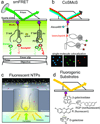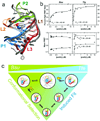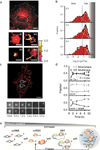Single-molecule tools for enzymology, structural biology, systems biology and nanotechnology: an update
- PMID: 25212907
- PMCID: PMC4615698
- DOI: 10.1007/s00204-014-1357-9
Single-molecule tools for enzymology, structural biology, systems biology and nanotechnology: an update
Abstract
Toxicology is the highly interdisciplinary field studying the adverse effects of chemicals on living organisms. It requires sensitive tools to detect such effects. After their initial implementation during the 1990s, single-molecule fluorescence detection tools were quickly recognized for their potential to contribute greatly to many different areas of scientific inquiry. In the intervening time, technical advances in the field have generated ever-improving spatial and temporal resolution and have enabled the application of single-molecule fluorescence to increasingly complex systems, such as live cells. In this review, we give an overview of the optical components necessary to implement the most common versions of single-molecule fluorescence detection. We then discuss current applications to enzymology and structural studies, systems biology, and nanotechnology, presenting the technical considerations that are unique to each area of study, along with noteworthy recent results. We also highlight future directions that have the potential to revolutionize these areas of study by further exploiting the capabilities of single-molecule fluorescence microscopy.
Conflict of interest statement
The authors declare that they have no conflict of interest.
Figures









Similar articles
-
Optical detection of single molecules in living cells.Sheng Li Xue Bao. 2005 Jun 25;57(3):271-7. Sheng Li Xue Bao. 2005. PMID: 15968420 Review.
-
Do-it-yourself guide: how to use the modern single-molecule toolkit.Nat Methods. 2008 Jun;5(6):475-89. doi: 10.1038/nmeth.1215. Nat Methods. 2008. PMID: 18511916 Free PMC article. Review.
-
Recent Advances in Biological Single-Molecule Applications of Optical Tweezers and Fluorescence Microscopy.Methods Enzymol. 2017;582:85-119. doi: 10.1016/bs.mie.2016.09.047. Epub 2016 Dec 12. Methods Enzymol. 2017. PMID: 28062046
-
Live cell single-molecule detection in systems biology.Wiley Interdiscip Rev Syst Biol Med. 2012 Mar-Apr;4(2):183-92. doi: 10.1002/wsbm.161. Epub 2011 Sep 12. Wiley Interdiscip Rev Syst Biol Med. 2012. PMID: 21913339 Review.
-
Imaging single molecules in living cells for systems biology.Mol Syst Biol. 2006;2:56. doi: 10.1038/msb4100100. Epub 2006 Oct 17. Mol Syst Biol. 2006. PMID: 17047663 Free PMC article. Review.
Cited by
-
Nanocaged enzymes with enhanced catalytic activity and increased stability against protease digestion.Nat Commun. 2016 Feb 10;7:10619. doi: 10.1038/ncomms10619. Nat Commun. 2016. PMID: 26861509 Free PMC article.
-
Life under the Microscope: Single-Molecule Fluorescence Highlights the RNA World.Chem Rev. 2018 Apr 25;118(8):4120-4155. doi: 10.1021/acs.chemrev.7b00519. Epub 2018 Jan 24. Chem Rev. 2018. PMID: 29363314 Free PMC article. Review.
-
Single Molecule Cluster Analysis dissects splicing pathway conformational dynamics.Nat Methods. 2015 Nov;12(11):1077-84. doi: 10.1038/nmeth.3602. Epub 2015 Sep 28. Nat Methods. 2015. PMID: 26414013 Free PMC article.
-
Using Single-Molecule FRET to Evaluate DNA Nanodevices at Work.Methods Mol Biol. 2023;2639:157-172. doi: 10.1007/978-1-0716-3028-0_10. Methods Mol Biol. 2023. PMID: 37166717
-
Nanoreporter of an Enzymatic Suicide Inactivation Pathway.Nano Lett. 2020 Nov 11;20(11):7819-7827. doi: 10.1021/acs.nanolett.0c01858. Epub 2020 Oct 29. Nano Lett. 2020. PMID: 33119310 Free PMC article.
References
Publication types
MeSH terms
Substances
Grants and funding
LinkOut - more resources
Full Text Sources
Other Literature Sources

